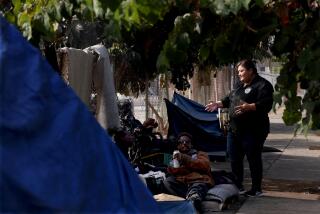9 Nights for Peace
The first member of St. Frances Xavier Cabrini Church to die was 16-year-old Lewis Wright, who was shot to death in his South-Central neighborhood.
Two days later, as Father David O’Connell opened the gates of Cabrini for Sunday morning services, he saw two dead bodies slumped inside a blood-drenched car, parked at the Winchell’s doughnut house next door. Church member Israel Pacheco was next, killed two nights later on West 111th Street on his way home from work. Then it was Daniel Sanchez, caught in a cross-fire of bullets six days later. The next day, David Burton was killed.
In a two-week period during October, six people died violent deaths in the neighborhood surrounding Cabrini and nearby Ascension Church. Four of the dead had been members of Cabrini.
Shaken by the murders, O’Connell vowed to mobilize his congregation. He organized 5,000 families from both churches into 91 discussion groups, using a Latin American ritual in which Catholics gather for nine nights leading up to today’s feast of the Virgin of Guadalupe.
Instead of meeting with them simply for prayer, as dictated by the tradition of Guadalupe, the priest directed church members to devise solutions to stem the violence.
The novena became merely an occasion to grieve in some houses. In others, it produced a fiery arena for change. Residents complained about abandoned houses that had become drug dens, phone booths that doubled as nighttime drug-dealing centers, gang members who scaled the walls of the neighborhood elementary schools to rob students and students who were too frightened to attend school.
At O’Connell’s urging, Los Angeles County Sheriff Lee Baca will visit St. Frances Cabrini Church on Saturday to meet members of the congregation and offer suggestions for addressing their complaints.
It was the shooting at Winchell’s--the one next to the church that killed the two non-parishioners--that shook O’Connell, who is pastor of the Cabrini and Ascension churches.
“I thought, ‘You just saw two dead bodies. What are you going to do about it?’ ” he said. “I want the people to ask themselves if their faith gives them courage to do something. You have to turn that anger into action.”
To ensure that parishioners communicated during the meetings last week, O’Connell distributed guides for the novena that included a reading from the Bible followed by a question for discussion each night.
On one night, parishioners were asked to compile lists of specific locations where crimes occurred in their neighborhoods. On another night, the question was: “If the Virgin Mary walked down the street where you live, what would she see? What would she ask you to do to change it?”
Guadalupe Corona, whose 17-year-old son, Francisco, was killed Aug. 8, spoke at a house meeting about the constant fear that had overcome her since her son died. Corona said she has also made several calls to police to remove the phone booth at 111th Street and Broadway where her son was shot. She said she had received no response.
“We can’t walk the streets without feeling nervous and scared,” she told the meeting. Several people nodded in agreement. “The police don’t seem to pay attention to us, either. Maybe together as a group, they will listen.”
What has happened in this neighborhood reflects the sharp climb in Los Angeles’ murder rate after eight years of decline. The homicide rate increased by almost 25% through mid-July, with three-quarters of the increase occurring in the southern and central parts of the city. As has been the case at Cabrini Church, the victims have been almost exclusively black and Latino males between 17 and 32.
Cabrini and Ascension Church make up one of the largest parish clusters in the Los Angeles Roman Catholic Archdiocese and serve areas patrolled by the Sheriff’s Department and the Los Angeles Police Department. Although police declined to comment on any particular murder investigation, detectives have been in regular contact with O’Connell and will visit the church to speak with members of the congregation.
O’Connell said one of the main problems is that most of the church members, who are immigrants from Mexico and Central America, fear speaking to authorities and remain silent when crimes occur. He said he hopes that parishioners will eventually become organized and confident enough to have regular meetings on crime in the neighborhood and better communication with police.
Elena Betran, a church member who participated in the house meetings, said her main concern is an abandoned house on 111th Street that has become a haven for drug dealers and junkies. It was in front of that house that Israel Pacheco, 25, was killed. Pacheco’s body was sent back to his family in Mexico for burial.
“I’m sick of it. Either they fix the place or demolish it. We don’t want this here,” she said in frustration.
Jose Lara said the meetings had already been fruitful for him. “A lot of us had seen each other in church, but never spoke or knew each other’s names. Through these meetings, we can share experiences and give each other support,” he said.
A more difficult hurdle is finding a way for the black and Latino church members to work together. Once a predominantly black church, Cabrini is now divided between middle-class, home-owning blacks and working-class Latino immigrants. Some members tend to spend more time placing blame on one another for the violence than working together on solutions, O’Connell said.
“That’s probably the saddest part of this story. The issue of violence affects both communities and if blacks and Latinos could work together, I think we would have a better chance to stop it,” he said.
More to Read
Sign up for Essential California
The most important California stories and recommendations in your inbox every morning.
You may occasionally receive promotional content from the Los Angeles Times.










